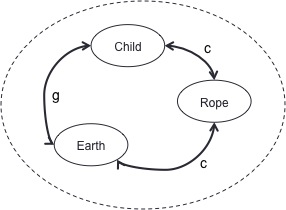
System schema are a useful representational tool for capturing important elements about the system we are trying to describe. It is easiest to understand the system schema by using an example to draw upon. The situation below will provide a context for drawing the system schema, and for representing a force diagram.
A child pulls herself up a rope using only her hands.

We begin drawing the system schema by identifying all of the objects that influence the situation we are describing. We represent each object with a circle and a label. In the example situation, there could be many objects that seem to be relevant, but our job is to identify only those that influence the situation. For example, would it matter if the child were wearing red shoes, blue shoes, or no shoes? No, so we can simplify and only identify the critical objects. In the example there are at least three important objects: the child, the rope, and the earth.

The next part of describing our situation is to identify the interactions between the objects. We represent these interactions with a two-headed arrow, and label the interaction. If the interaction is always taking place the arrow is solid-line, if the interaction only takes place for a particular period of time the arrow is a dashed-line. In our example the child is always touching the rope, so that is a contact interaction between the child and the rope. The rope is somehow hanging (note that we don't care if the rope is hanging from a tree or a bridge, only that it is hanging), so that's a contact interaction between the rope and the earth. Finally, the earth and the child are interacting. We know there is gravity, and to have a force there must be an interaction, so we identify a gravitational interaction between the earth and the child.

The final step in creating a system schema is to identify what objects are inside the system we are interested in describing. This is of primary importance when using the system schema in the context of energy, which we will discuss later in the semester. You identify the system with a dotted line around the objects of interest. In our example we will simply include all of the objects as part of our system.

Now we have a system schema. To use this representation to help draw a force diagram, start by identifying the object of interest, in this case we'll choose the child. The object is represented by a dot in the force diagram. Now consider each interaction touching the object of interest. In our example there are two interactions with the child, the contact interaction with the rope and the gravitational interaction with the earth. For each interaction, draw and label a force acting on the dot in the force diagram.

Follow-ons:
Vashti Sawtelle & Eric Brewe 8/20/12